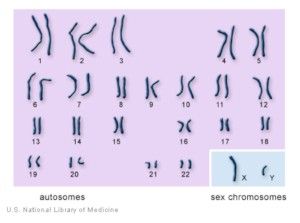
Topic 1: What is a gene? What is GNAQ? Why does it matter?
What is a gene?
It turns out that we have over 3 billion base pairs of DNA, arranged in the famous double helix that Crick and Watson figured out in 1953. And all that DNA is organized into chromosomes—for girls it’s chromosomes 1 through 22 plus two copies of X; for boys it’s chromosomes 1 through 22 plus an X and a Y. (This picture if from the National Institutes of Health and is in the public domain.)
Let’s look at chromosome 9. From end to end its length is 141,213,431 base pairs of DNA—that’s 141 million of the building blocks (called A, C, T, G). And scattered along that chromosome we can find 2,253 genes.
So the gene is something made of DNA and is part of a chromosome. And it turns out we have 20,000 genes that make proteins (we’ll talk about what a protein is another time). Genes are too small to see, but for over a hundred years we’ve known what they do. They can control eye color, or development of the limbs, or height, and all sorts of other features. They’ve been called the “blueprint of a house” and that’s a nice metaphor. A house has walls, plumbing, stairs, and other parts that we see; similarly a cell has different features we can see including a transport system, a garbage disposal system, and walls. The DNA blueprint gets turned into proteins that let a cell do its job.
What is GNAQ?
One of our genes is called GNAQ. It sits on chromosome 9, and it makes a protein called Gaq (pronounced G alpha Q). NIH offers a web page that introduces it: https://ghr.nlm.nih.gov/gene/GNAQ. To view the DNA sequence from the NIH website, go to: https://www.ncbi.nlm.nih.gov/nuccore/NM_002072.4. There are 6,343 bases of DNA (using the alphabet “G, A, T, C”).
Why does it matter?
In Sturge-Weber syndrome and in port-wine birthmarks, just one of those bases changes.
The change is called R183Q.
Q: When does it happen?
A: Before birth.
Q: Does it happen in mom’s egg or dad’s sperm?
A: No, it happens by chance during development of the fetus.
Q: Where does it happen?
A: Mostly in endothelial cells.
Q: Why does it happen?
A: Mutations happen very, very often. They’re part of life.
Q: What does it do?
A: It turns on the GNAC protein--too much.
Q: How does it relate to cancer?
A: The same R183Q mutation can cause melanoma of the eye (uveal melanoma): it happens at a different time of life (not during early development), in a different cell type (melanocytes not endothelial cells), and people with SWS or port-wine birthmarks are not at increased risk for getting that cancer.
Let’s cover some of these questions in other posts—for example I’d like to introduce you to the Gaq protein, explain what it means for it to be turned on, and tell you how researchers are trying to figure out how to turn it back off.
Conclusions: the bigger picture
There are many ways to try to help someone with Sturge-Weber syndrome. Doctors, nurses, therapists of various sorts can all help understand the condition and its complications including the most effective treatments. Those of us involved in research are focused on understanding the underlying causes. Much of this happens at the molecular level, and dealing with genes and proteins and cells may seem abstract because we don’t see them in our everyday lives. In this post I introduced the concept of the gene and mentioned GNAQ, the gene that harbors a mutation that causes Sturge-Weber syndrome and port-wine birthmarks. I hope this gives you an initial background so we can talk about the many ways the research community can solve the puzzle of what causes the brain, eye, skin, and other complications of Sturge-Weber syndrome from seizures to birthmarks to headaches.
Here’s what we can do, knowing that GNAQ mutations cause SWS:
· Knowing the gene we can study how it works inside a cell, and what the consequences are of the mutation
· We can study how it works in many other organisms (many of which are far easier to study than in humans)
· We can create the mutation that causes SWS in model organisms (such as mouse and fish), see the effects, try to fix them, and take what we’ve learned back to
patients with SWS
· Knowing that the same mutation in the same gene can cause uveal melanoma we can see what strategies the cancer community has taken to solve the effect of
mutated GNAQ.
All of this is meant to help us get close to figuring out treatments that can help treat the root causes of SWS.







